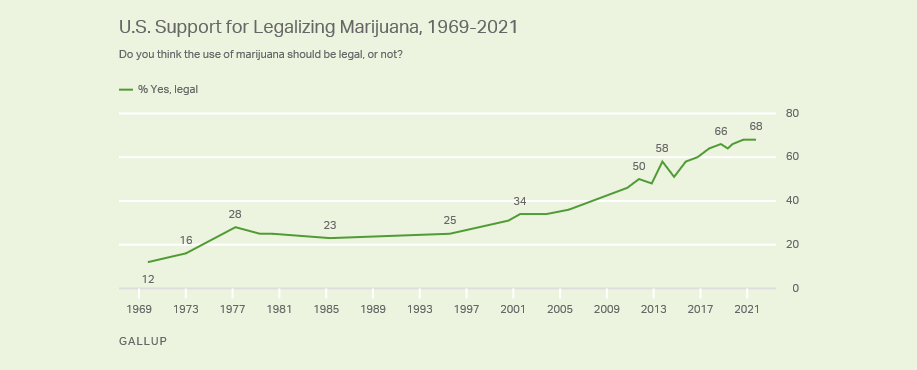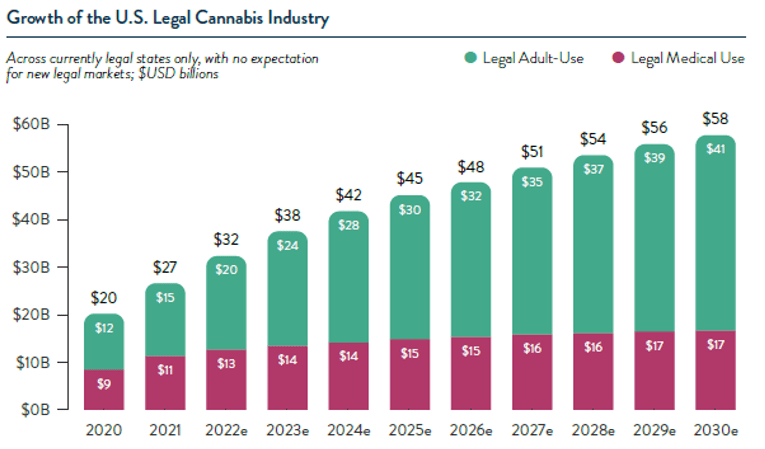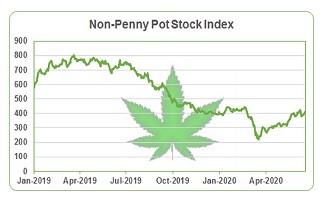U.S. federal legalization regarding the sale and financial administration of cannabis companies still faces hurdles but state-level momentum is projected to continue this year. Below is the performance in April and YTD of the 13 largest American Multi-State Operators (MSOs) as tracked by the munKNEE Pure-play American MSO Pot Stock Index.
Growth In Acceptance of Cannabis
A recent poll by the American Bankers Association found that:
- 68% of Americans support the legalization of marijuana and
- 65% believe marijuana firms should be allowed access to traditional banking services in states where cannabis is legal without the threat of federal penalties and support Congress passing legalization that would allow such access.


Growth In the Cannabis Market
In addition to growing support for legalizing cannabis there is considerable growth in the cannabis market with annual legal cannabis sales in the U.S. expected to expand at a compound annual growth rate (CAGR) of 11% between 2020 and 2030, surpassing $57 billion as a result of robust consumer demand and newly operational legal state markets.


Growth In Range of Cannabis Consumers
Women now account for 33% of all cannabis consumers in the U.S., with over half of them under the age of 40, according to Akerna, a cannabis trend research business.
In addition, according to Headset, a cannabis data company, cannabis sales among Gen Z consumers increased by 127% in 2020, compared to just 46% and 29%, respectively, by their Millennial and Gen X counterparts so, as more Gen Zers turn 21, this demographic will likely continue to drive exponential growth.
Growth In Cannabis Usage
As more states ease legislation and new consumers enter the market, there will be an increase in innovative product offerings, contributing to the major upswing in marijuana use going forward.
Headwinds
The above being said, there are considerable headwinds.
- The U.S. House of Representatives passed the Marijuana Opportunity Reinvestment and Expungement Act (MORE Act) on April 1 BUT the introduction of the Senate’s version of the MORE Act, called the Cannabis Administration and Opportunity Act (CAOA), has been postponed until later in the session by Senate Majority Leader Chuck Schumer to give him more time to rally support for the bill from a few Republicans to ensure its passage – and that is not a foregone conclusion.
- If passed, CAOA would:
- end the federal ban on cannabis,
- leave legalization up to the states,
- decriminalize marijuana
- and would allow banks and other financial institutions to provide banking services to cannabis companies which, currently, are subject to criminal prosecution under federal law.
- If passed, CAOA would:
- In February, House members voted to include the banking provisions of the Secure and Fair Enforcement Banking Act of 2021 (the SAFE Act) in the Creating Opportunities for Manufacturing, Pre-Eminence in Technology, and Economic Strength Act (the COMPETES Act) but they were not included in the Senate version of the COMPETES Act late last month implying that federal legalization is unlikely to happen anytime soon.
Tailwinds
While federal legalization still faces hurdles, state-level momentum is projected to continue this year after an eventful 2021 during which adult-use cannabis became legal in Connecticut, New Mexico, New York, and Virginia bringing the total to 18 states, the District of Colombia and Guam. (Recreational marijuana sales commenced in New Jersey in April of this year.)
Mid-term elections usually result in an increase in the number of states legalizing cannabis as the result of ballot initiatives and 2022 is no exception. Adult-use ballot initiatives are being proposed in Arkansas, Maryland, Ohio, and South Dakota and both adult-use and medical ballot initiatives are being proposed in Idaho, Missouri, Nebraska, and Oklahoma.
These legislation reform initiatives at the state level, for both medical and adult marijuana use, may act as a tailwind for legalization at the federal level.
The munKNEE Pure-Play American MSO Pot Stock Sub-Index
The American MSO Pot Stock Index consists of the 13 largest pure-play, vertically integrated multi-state operators whose stocks trade for at least US$1/share, have a market cap of at least US$300M (Goodness Growth is less but will soon be owned and incorporated into Verano), and trade on one or more of the Canadian and/or American stock exchanges.
Below is how the 13 constituents performed in April, in descending order, with their year-to-date performances in brackets:
You will note that each constituent in the analyses below has 5 areas of additional information that are imperative for any individual considering investing in this sector:
- The company name is hyperlinked to its website to provide you with a description of the company and an analysis of its stock.
- The trading symbol is hyperlinked to additional financial data and commentary on the company (where available).
- The Chance of Financial Distress percentage is sourced from macroaxis.com.
- The buy/hold/sell analyst consensus is sourced from stockanalysis.com.
- The articles are hyperlinked to provide easy access to the latest analyses and commentaries.
- Acreage (ACRDF/ACRHF): -13.2%; (-7.7% YTD)
- Chance of Financial Distress in next 2 years: +73%
- Analyst Consensus: None following Acreage
- Recent Analysis/Commentary:
- Verano (VRNOF): -16.8%; (-37.4% YTD)
- Chance of Financial Distress in next 2 years: 43%
- Analyst Consensus: None following VRNOF
- Recent Analysis/Commentary:
- Curaleaf (CURLF): -18.1%; (-34.4% YTD)
- TerrAscend (TRSSF): -18.4%; (-23.0% YTD)
- Chance of Financial Distress in next 2 years: +63%
- Analyst Consensus: None following TRSSF
- Recent Analyses/Commentaries:
- Jushi (JUSHF): -18.5%; (-28.0% YTD)
- Chance of Financial Distress in next 2 years: +70%
- Analyst Consensus: None following JUSHI
- Latest Analyses/Commentaries:
- Goodness Growth (GDNSF): -19.2%; (-1.8% YTD)
- Chance of Financial Distress in next 2 years: +70%
- Analyst Consensus: None following GDNSF
- Ascend Wellness (AAWH): -19.4%; (-50.5% YTD)
- Green Thumb (GTBIF): -24.4%; (-36.4% YTD)
- Cresco (CRLBF): -26.8%; (-34.0% YTD)
- Chance of Financial Distress in next 2 years: +70%
- Analyst Consensus: None following CRLBF
- Recent Analysis/Commentary: Cresco Labs: New Jersey Boost, But No Federal Help
- Planet 13 (PLNHF): -29.2%; (-39.5% YTD)
- Trulieve (TCNNF): -31.3%; (-44.5% YTD)
- Columbia Care (CCHWF): -32.2%; (-28.7% YTD)
- Chance of Financial Distress in next 2 years: +67%
- Analyst Consensus: None following CCHWF
- Ayr Wellness (AYRWF): -45.1%; (-52.1% YTD)
April was a terrible month for the Pure-Play American MSO Pot Stock Index with NO constituent advancing. The Index declined 27.5% and is now down 38.6% YTD – and DOWN 71.7% from its peak in 2021.
Action Going Forward
If history is any guide, this emotional negative reaction to the delay in the introduction of the Senate cannabis bill suggests that now would be a good time to consider taking positions in one or more of the cannabis stocks mentioned above as we should expect a significant runup in their prices just prior to the introduction of the proposed CAOA.
Notes: All numbers in CAD unless otherwise stated. The author of this report, and employees, consultants, and family of eResearch may own stock positions in companies mentioned in this article and may have been paid by a company mentioned in the article or research report. eResearch offers no representations or warranties that any of the information contained in this article is accurate or complete. Articles on eresearch.com are provided for general informational purposes only and do not constitute financial, investment, tax, legal, or accounting advice nor does it constitute an offer or solicitation to buy or sell any securities referred to. Individual circumstances and current events are critical to sound investment planning; anyone wishing to act on this information should consult with a financial advisor. The article may contain “forward-looking statements” within the meaning of applicable securities legislation. Forward-looking statements are based on the opinions and assumptions of the Company’s management as of the date made. They are inherently susceptible to uncertainty and other factors that could cause actual events/results to differ materially from these forward-looking statements. Additional risks and uncertainties, including those that the Company does not know about now or that it currently deems immaterial, may also adversely affect the Company’s business or any investment therein. Any projections given are principally intended for use as objectives and are not intended, and should not be taken, as assurances that the projected results will be obtained by the Company. The assumptions used may not prove to be accurate and a potential decline in the Company’s financial condition or results of operations may negatively impact the value of its securities. Please read eResearch’s full disclaimer.



